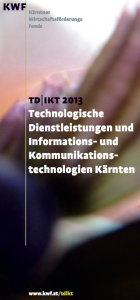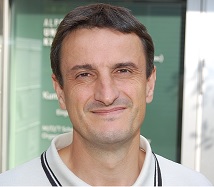 Technologische Dienstleistungen, Informations- und Kommunikationstechnologien Kärnten [PDF]
Technologische Dienstleistungen, Informations- und Kommunikationstechnologien Kärnten [PDF]
Prämiert und gefördert werden innovative Projektvorhaben im Bereich wissensbasierter Dienstleistungen und technologieorientierter Innovationen.
Das wird gefördert
Mit der Ausschreibung »TD|IKT Technologische Dienstleistungen und Informations- und Kommunikationstechnologien Kärnten 2013« unterstützt der KWF Kärntner Wirtschaftsförderungs Fonds innovative Projekte von Kärntner KMU^2 des sekundären (Produzierender Bereich) und tertiären (Dienstleistungsbereich) Wirtschaftssektors im Bereich wissensbasierter Dienstleistungen und technologieorientierter Innovationen. Eingereichte Projektvorhaben führen zu neuen oder deutlich verbesserten marktgängigen Produkten, Verfahren oder Dienstleistungen und somit zu einer gestärkten Wettbewerbssituation der teilnehmenden Unternehmen. Die Projekte können in eigener Entwicklungsarbeit, aber auch in Zusammenarbeit mit einer wissenschaftlichen Einrichtung, einer Schule oder einem anderen Unternehmen realisiert werden.
Großunternehmen bzw. Unternehmen aus dem Ausland können im Zuge dieser Ausschreibung lediglich als externe Auftragnehmer für projektbezogene Teilbereiche integriert werden.
Einreichungen sind mittels Online-Einreichformular bis 08. Mai 2013, 12:00 Uhr möglich. Nach Anmeldung mittels E-Mail-Adresse erfolgt die Übermittlung der Formularnummer. Mit diesen Zugangsdaten können Projektanträge von jedem Computer mit Internetverbindung jederzeit bearbeitet und bereits eingegebene Daten aufgerufen werden. Endgültig übermittelte Projektanträge werden mittels Bestätigungsemail quittiert.

 Abstract: Many daily activities we want to finish as fast and smoothly as possible. The same applies when we use our computing devices. Examples range from low-level actions, such as selecting the “Print” item from the “File” menu or clicking on desktop icons, to higher level activities and more complex tasks, such as finding the favorite holiday photo in the personal collection, or to use a smartphone to navigate a city map or to browse a long list of products before deciding on a purchase. Throughout the years, the desire for interaction efficiency has motivated the Human-Computer Interaction research community to seek and explore new interaction mechanisms and user interface techniques that improve on the state of the art. In this talk I will present a handful of past projects in which we have applied the experimental method to arrive at insights regarding novel user interface design solutions.
Abstract: Many daily activities we want to finish as fast and smoothly as possible. The same applies when we use our computing devices. Examples range from low-level actions, such as selecting the “Print” item from the “File” menu or clicking on desktop icons, to higher level activities and more complex tasks, such as finding the favorite holiday photo in the personal collection, or to use a smartphone to navigate a city map or to browse a long list of products before deciding on a purchase. Throughout the years, the desire for interaction efficiency has motivated the Human-Computer Interaction research community to seek and explore new interaction mechanisms and user interface techniques that improve on the state of the art. In this talk I will present a handful of past projects in which we have applied the experimental method to arrive at insights regarding novel user interface design solutions.
 Abstract: Software is omnipresent. It is key to successful businesses and has become key to our social activities. As many systems, also software systems need to change in order to stay successful on the market. However, these changes cause software systems to become larger in size and more complex as described by Lehman’s Laws of Software Evolution. As a consequence, more resources are needed to maintain, or in general, evolve a software system. Evolving software systems is therefore mastering change and system complexity. The goal of my research and teaching is to provide software engineers with means to master this challenge.
Abstract: Software is omnipresent. It is key to successful businesses and has become key to our social activities. As many systems, also software systems need to change in order to stay successful on the market. However, these changes cause software systems to become larger in size and more complex as described by Lehman’s Laws of Software Evolution. As a consequence, more resources are needed to maintain, or in general, evolve a software system. Evolving software systems is therefore mastering change and system complexity. The goal of my research and teaching is to provide software engineers with means to master this challenge.